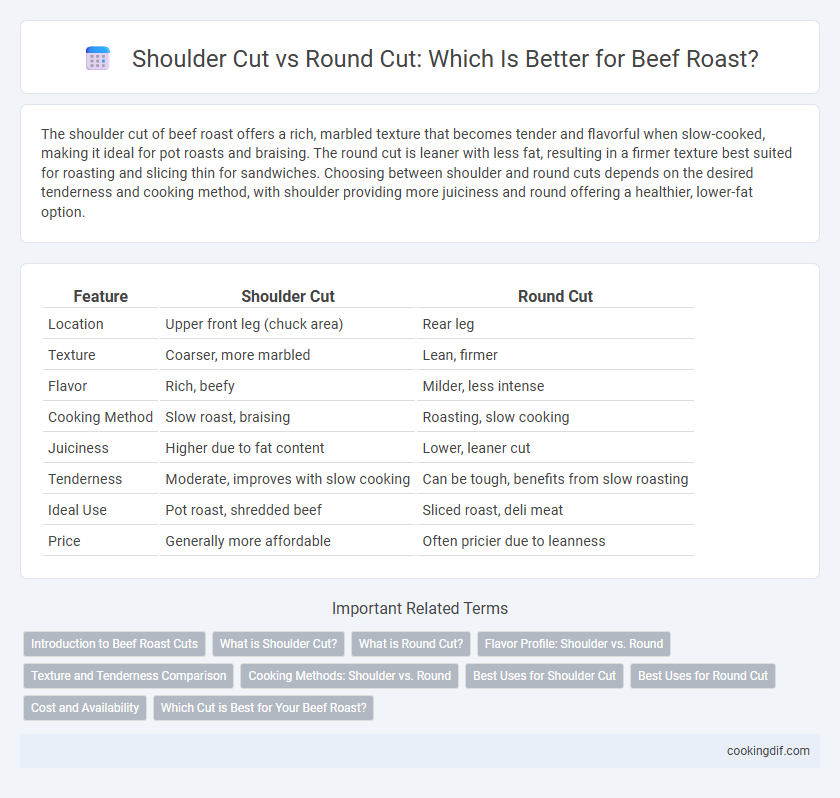The shoulder cut of beef roast offers a rich, marbled texture that becomes tender and flavorful when slow-cooked, making it ideal for pot roasts and braising. The round cut is leaner with less fat, resulting in a firmer texture best suited for roasting and slicing thin for sandwiches. Choosing between shoulder and round cuts depends on the desired tenderness and cooking method, with shoulder providing more juiciness and round offering a healthier, lower-fat option.
Table of Comparison
| Feature | Shoulder Cut | Round Cut |
|---|---|---|
| Location | Upper front leg (chuck area) | Rear leg |
| Texture | Coarser, more marbled | Lean, firmer |
| Flavor | Rich, beefy | Milder, less intense |
| Cooking Method | Slow roast, braising | Roasting, slow cooking |
| Juiciness | Higher due to fat content | Lower, leaner cut |
| Tenderness | Moderate, improves with slow cooking | Can be tough, benefits from slow roasting |
| Ideal Use | Pot roast, shredded beef | Sliced roast, deli meat |
| Price | Generally more affordable | Often pricier due to leanness |
Introduction to Beef Roast Cuts
Beef roast cuts vary significantly in tenderness and flavor, with shoulder cut offering rich marbling and a robust, beefy taste ideal for slow roasting. The round cut, sourced from the rear leg, is leaner and firmer, making it suitable for lean roast dishes but requiring careful cooking to avoid dryness. Understanding these differences helps select the optimal cut based on cooking method and desired texture.
What is Shoulder Cut?
The shoulder cut, also known as the chuck, is a flavorful and well-marbled section of beef ideal for roasting, braising, or slow cooking. It contains connective tissue that breaks down during cooking, resulting in tender, juicy meat with rich taste. Shoulder cuts are typically more affordable than round cuts and are perfect for pot roasts and stews.
What is Round Cut?
Round cut comes from the rear leg of the cow and is known for its lean meat with minimal marbling, making it a healthier option but potentially less tender than other cuts. This cut is ideal for slow roasting, braising, or pot roasting, which helps break down the muscle fibers and enhance tenderness. Compared to shoulder cut, round cut typically has a firmer texture and milder flavor, requiring careful cooking techniques to prevent dryness.
Flavor Profile: Shoulder vs. Round
The shoulder cut offers a rich, beefy flavor with ample marbling that enhances juiciness and tenderness during roasting. In contrast, the round cut tends to be leaner with a milder taste, often requiring slower cooking methods to break down its firmer texture. Choosing shoulder yields a more robust and savory roast, while round is suited for leaner, milder-flavored preparations.
Texture and Tenderness Comparison
The shoulder cut of beef roast offers a rich marbling that results in a tender and juicy texture when slow-cooked, making it ideal for braising or pot roasting. In contrast, the round cut is leaner with less intramuscular fat, leading to a firmer texture and requiring careful cooking methods to prevent toughness. Choosing shoulder over round cut enhances tenderness due to its higher connective tissue content, which breaks down into flavorful gelatin during prolonged cooking.
Cooking Methods: Shoulder vs. Round
Shoulder cuts for beef roast benefit from slow cooking methods such as braising or slow roasting to break down the connective tissues, resulting in tender, flavorful meat. Round cuts are leaner and best suited for dry-heat methods like roasting or grilling at moderate temperatures to maintain juiciness without toughness. Properly matching the cooking method to the cut's muscle composition ensures optimal texture and taste in the final roast.
Best Uses for Shoulder Cut
Shoulder cut beef roast, often known as chuck roast, is ideal for slow-cooking methods such as braising and stewing due to its rich marbling and connective tissue. This cut becomes tender and flavorful when cooked low and slow, making it perfect for pot roasts, shredded beef, and hearty stews. Unlike leaner round cuts, shoulder cuts offer a juicier texture and deeper beef flavor, enhancing dishes that require prolonged cooking times.
Best Uses for Round Cut
Round cut beef roast is best suited for slow-cooking methods such as braising or roasting at low temperatures to maintain tenderness. Its lean composition and firmer texture make it ideal for dishes like pot roast, stews, or thinly sliced roast beef sandwiches. Round cut benefits from moist heat cooking to break down connective tissue and enhance flavor absorption.
Cost and Availability
Shoulder cut beef roast is generally more affordable and widely available compared to round cut, making it a popular choice for budget-conscious consumers. Round cut tends to be leaner but often comes at a higher price due to its demand for healthier options and specific cooking uses. Both cuts are commonly found in supermarkets, but shoulder cut's versatility and lower cost make it more accessible in various markets.
Which Cut is Best for Your Beef Roast?
Shoulder cuts offer rich marbling and connective tissue, making them ideal for slow roasting methods that yield tender, flavorful beef roast. Round cuts are leaner with less fat, perfect for those seeking a healthier option but require careful cooking to prevent dryness. Choosing between shoulder and round depends on your preference for tenderness and fat content in your beef roast.
Shoulder cut vs round cut for beef roast Infographic

 cookingdif.com
cookingdif.com